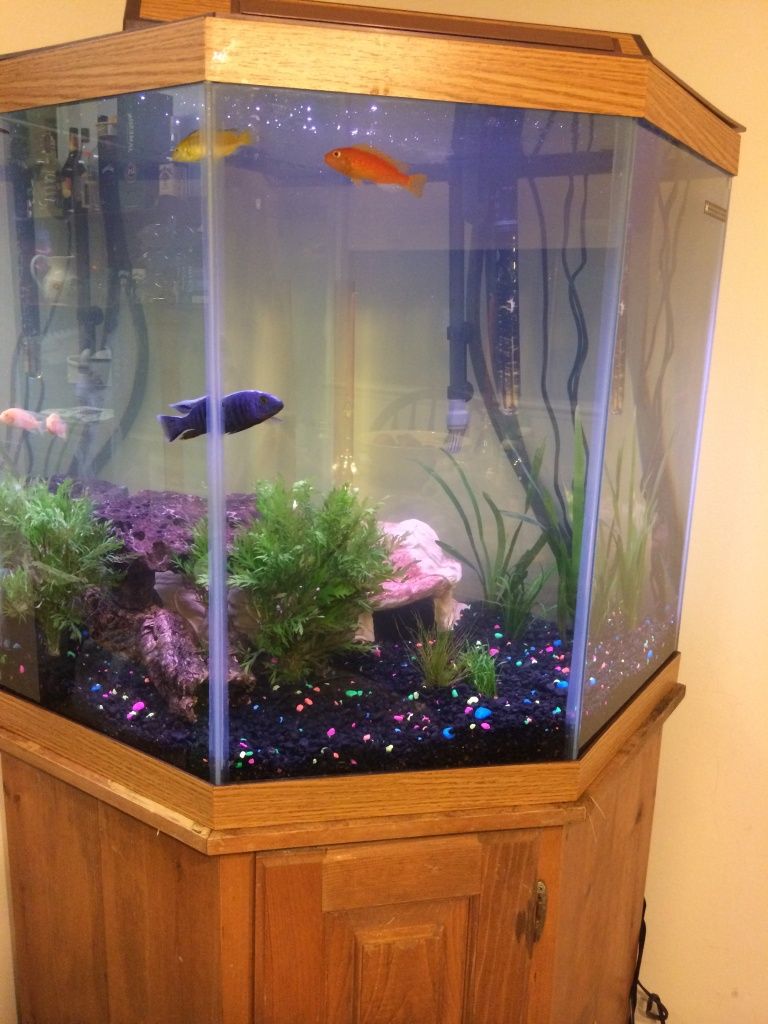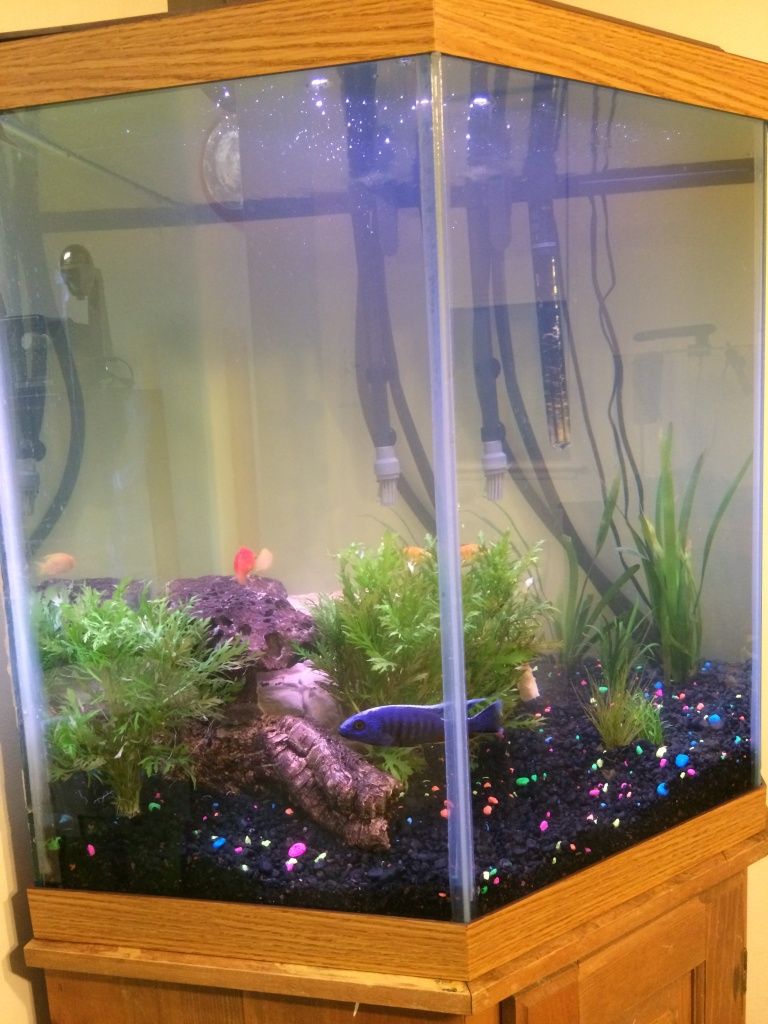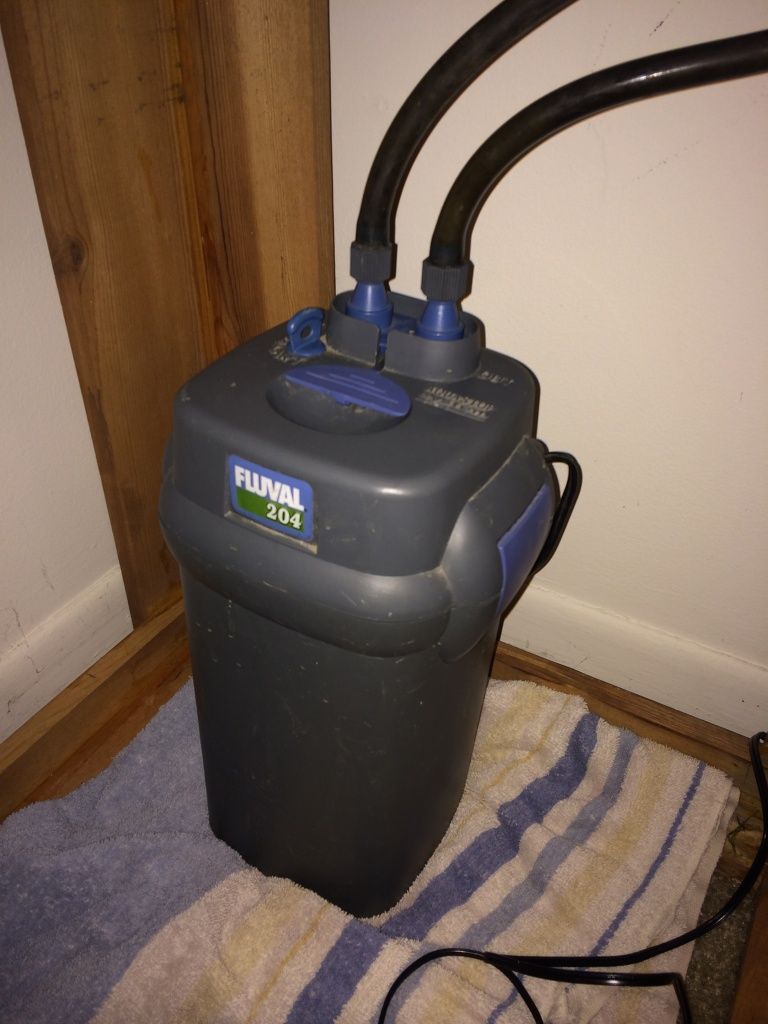rthompson14
Member
Hey guys!!!
Ok, so for the past 6 or 8 months my 2 South American Chiclids and my 1 African Chiclid have been stuck in a 10gal, and my African Chiclid has grown so much in the past months. They have been due for a serious upgrade. Poor guys. The African is agressive and many people dont mix them with South American Chiclids. I found they pretty much left each other alone, but when the African Chiclid was out of his house "cove" they all ran and hid. Typical.
Anyway I picked up a 44 gallon corner Pentagon Glass tank off craigslist for $100 with a bad light fixture. Came with heater and large external filter....which I dont know much about. I'll post pics tomarrow of the filter.....though I got it running I dont wanna take it apart for internal pics. I was hoping someone could tell me about the filter and how often to clean "everything" in it. It's a canister filter, divided into 2 major sections. On the left is a cartridge that holds 4 sponges...that one I understand. On the right is a stack of 3 sections....top section has what looks like gravel, middle section has ceramic "pellets with holes in the middle", bottom section has gravel. I'm guessing that every 2 weeks or so I should throughouly rinse every part of the inside of this filter? Wasn't sure if one of the sections might be for bacterial growth and should be left alone.
So I hit the LFS and picked up a new light fixture ($-40) and a T8 high lumen bulb ($-18) as I am doing live plants (first time dabbling in live plants) that require high light (cause the selection was bigger than that of the low light plants). Got a random cattail? (honestly not sure what kinda plant it is) and some special gravel that has all kinds of good stuff in it for live plants, and was told I could mix it with regular gravel. So I picked up 30 lbs of the plant gravel and 15lbs of the normal gravel. Got about a 3" bed in the bottom of the tank.
I've never used a gravel filter nor do I know anything about it. When setting up my tank I put this large white gravel filter in the bottom and covered it with gravel, in the rear it has a large tube that goes about 3/4 of the way to the top of the tank.....so assuming bad stuff settles down through the gravel and goes up through the tube....I have the top of this tube very close to my inlet for my external filter......and I'm guessing this is set up right? The tank came with a HUGE box of extra tubes and hang on back filters and resivoirs and all kinds of fake plants and such. So I may not have the gravel filter set up right, hoping you guys would know a little about that?
So all my chiclids are getting along great now, they have plenty of room so they don't really seem to bother each other...I think they are in a much happier place now ....It's late so I don't have it in me to take pics and upload tonight, but will follow this post tomarrow after work with pics of the tank.
....It's late so I don't have it in me to take pics and upload tonight, but will follow this post tomarrow after work with pics of the tank.
Suggestions on the setup of the gravel filter guys?

Ok, so for the past 6 or 8 months my 2 South American Chiclids and my 1 African Chiclid have been stuck in a 10gal, and my African Chiclid has grown so much in the past months. They have been due for a serious upgrade. Poor guys. The African is agressive and many people dont mix them with South American Chiclids. I found they pretty much left each other alone, but when the African Chiclid was out of his house "cove" they all ran and hid. Typical.
Anyway I picked up a 44 gallon corner Pentagon Glass tank off craigslist for $100 with a bad light fixture. Came with heater and large external filter....which I dont know much about. I'll post pics tomarrow of the filter.....though I got it running I dont wanna take it apart for internal pics. I was hoping someone could tell me about the filter and how often to clean "everything" in it. It's a canister filter, divided into 2 major sections. On the left is a cartridge that holds 4 sponges...that one I understand. On the right is a stack of 3 sections....top section has what looks like gravel, middle section has ceramic "pellets with holes in the middle", bottom section has gravel. I'm guessing that every 2 weeks or so I should throughouly rinse every part of the inside of this filter? Wasn't sure if one of the sections might be for bacterial growth and should be left alone.
So I hit the LFS and picked up a new light fixture ($-40) and a T8 high lumen bulb ($-18) as I am doing live plants (first time dabbling in live plants) that require high light (cause the selection was bigger than that of the low light plants). Got a random cattail? (honestly not sure what kinda plant it is) and some special gravel that has all kinds of good stuff in it for live plants, and was told I could mix it with regular gravel. So I picked up 30 lbs of the plant gravel and 15lbs of the normal gravel. Got about a 3" bed in the bottom of the tank.
I've never used a gravel filter nor do I know anything about it. When setting up my tank I put this large white gravel filter in the bottom and covered it with gravel, in the rear it has a large tube that goes about 3/4 of the way to the top of the tank.....so assuming bad stuff settles down through the gravel and goes up through the tube....I have the top of this tube very close to my inlet for my external filter......and I'm guessing this is set up right? The tank came with a HUGE box of extra tubes and hang on back filters and resivoirs and all kinds of fake plants and such. So I may not have the gravel filter set up right, hoping you guys would know a little about that?
So all my chiclids are getting along great now, they have plenty of room so they don't really seem to bother each other...I think they are in a much happier place now
Suggestions on the setup of the gravel filter guys?



